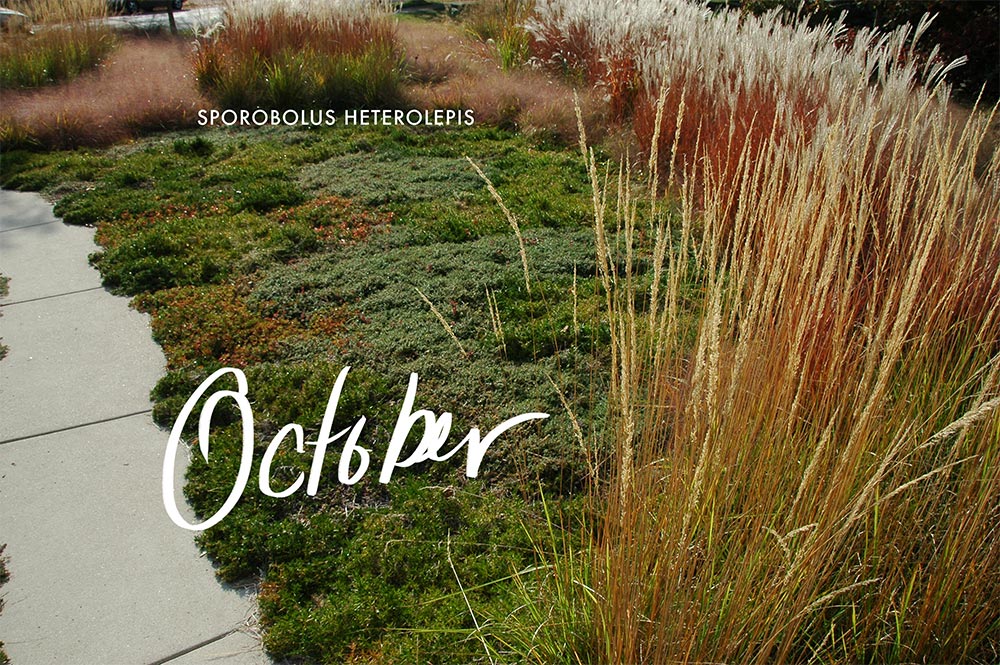Transitioning a front yard from the standard American flat patch of obsessively produced green lawn into something more waterwise (and less fertilizer intensive) is a smart trend among many suburban homeowners. (And I couldn’t be happier to support a lawn-free front yard meadow conversion!). Drought, oil costs, and climate change are fueling the desire for change, but many homeowners struggle to imagine something new and different. This suburban front yard meadow and sedum lawn is full of ideas, plants, and design advice from landscape professionals who created a beautiful grass-free alternative to the typical suburban front garden.
The Design Challenge – Turn lawn into a creative meadow:
With a directive to make the front walk more useable and attractive, designer Claire Kettelkamp of Kettelkamp and Kettelkamp Landscape Architects was hired to re-imagine this small front garden in Evanston, Illinois.
The new plan banished the hostas that intruded onto the sidewalk and got people wet as they brushed past. It also needed to require no irrigation or maintenance and no special garden tools or chemicals. The result was a front yard meadow of tall grasses and a lawn-free “lawn” that was inspired by a green roof design. It is a colorful seasonal palette that checks all the requirements.
Use these ideas to create your own low-maintenance and inventive front garden (or backyard meadow!).


Claire Kettlekamp describes the front yard meadow’s design:
On choosing tough plants and taking inspiration from Green Roof style planting choices:
“Seasonal interest was really important, and that was hard. In the middle of the front lawn is a clearing. There is a series of different sedums, creeping phlox, and thyme. The plants that are generally used on a green roof inspired us because the clients didn’t want tall plants near the walk that would get their clothes wet, but they did want drought-tolerant plants. We chose a lot of sedums that are either evergreen or turn scarlet and added thyme and creeping phlox for spring color.”
How did you plant? What was the spacing, and how long did the ground cover take to fill in?
“The ground cover filled in fast; I planted it close (6-8inches on center) because I was concerned about weeds and making sure that the homeowners could take care of it easily by themselves.”
How did the layout and the placement of the front walkway inspire the planting design?
“The front walk was the inspiration – it may not look like the most efficient path, but it is the most efficient way to get to the train station (from the house). For the planting inspiration, I turned the path on the bias (at an angle) to get the high low layout of the grasses.”
On how to create a path through the front yard meadow that slows you down and feels calming as you walk over it:
“We also pinched the width of the walkway in the center so that it kind of slows you down in your journey from the sidewalk to the front door. It makes your take in the garden and walk is a little more interesting.”
-Claire Kettlecamp

A Water Wise, Lawn-Free, Plant List:
- Sedum floriferum ‘Weinstephaners Gold’
- Thymus praecox
- Sedum requienii
- Phlox subulata ‘Blue Emerald’
- Sedum cauticola
- Sedum rupestre ‘Forsteranum’
Options for Front Yard Meadow Grasses:
- Miscanthus sinensis ‘Silberfeder’
- Calamagrostis acutiflora ‘Karl Forester’
- Eragrostis spectabilis
- Sporobolus heterolepis
- Carex pennsylvanica (not shown)


“People love it or hate it. I think it’s good that it gets a reaction because it means it is different and it reflects the process that went into designing it. The owners have received fan mail for the garden that has made us feel very good over the years”
-Claire Kettlekamp
Why do people hate it?
“It’s tall. People really are used to the aesthetic of the American lawn in front of the house. So it can be a shock. It is not a flower garden, so sometimes people don’t understand what it is.”
-Claire Kettlekamp
The final design is a waterwise suburban meadow of tall grasses and a lawn that isn’t actually a lawn. What do you think? Love it or loathe it?
Personally, I’m not just in love but in admiration. I admire Claire for her lawn-free front yard meadow design, but also the homeowners for their vision and ability to try something new. I hope trends continue to shift and this type of small front yard design becomes not just acceptable but fashionable.
Images provided by Claire Kettelkamp.
